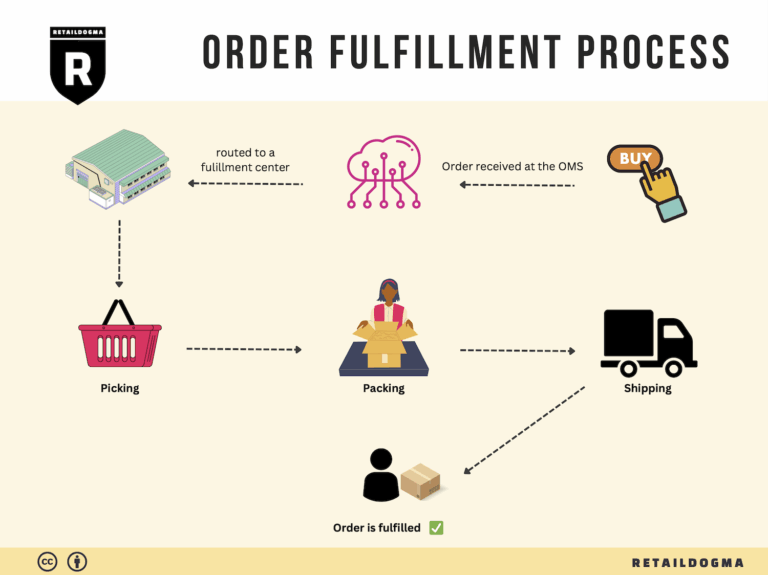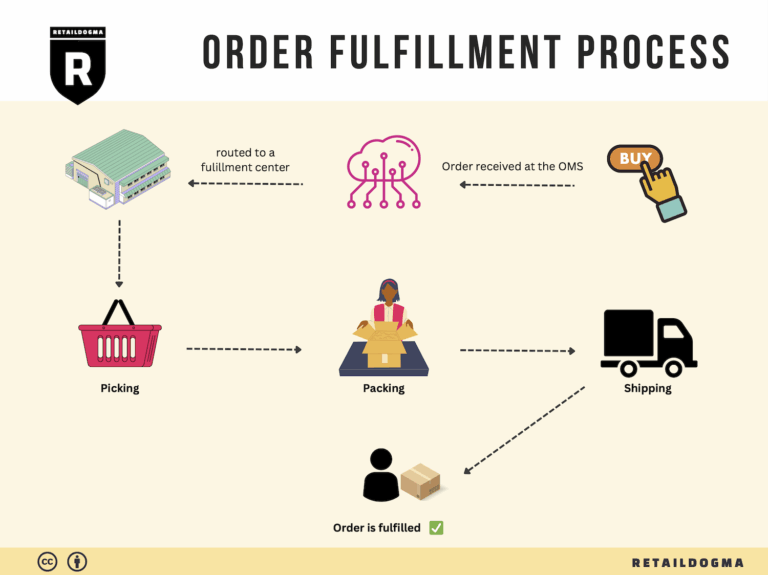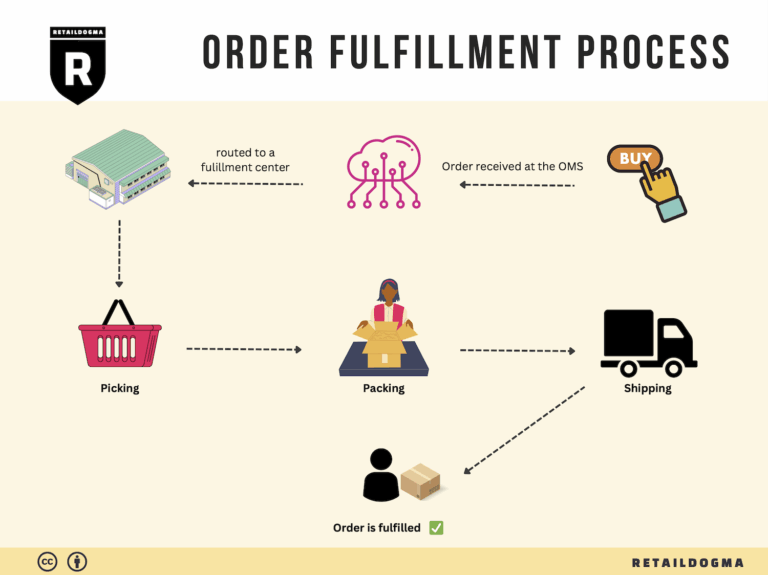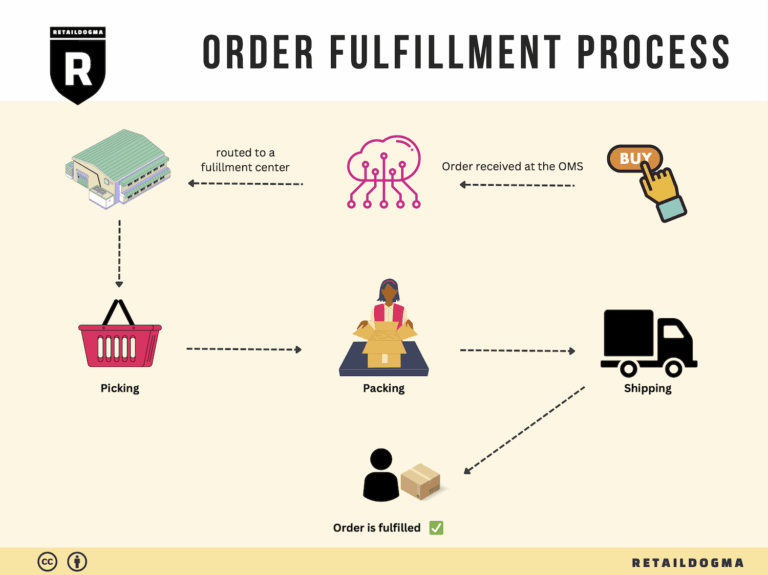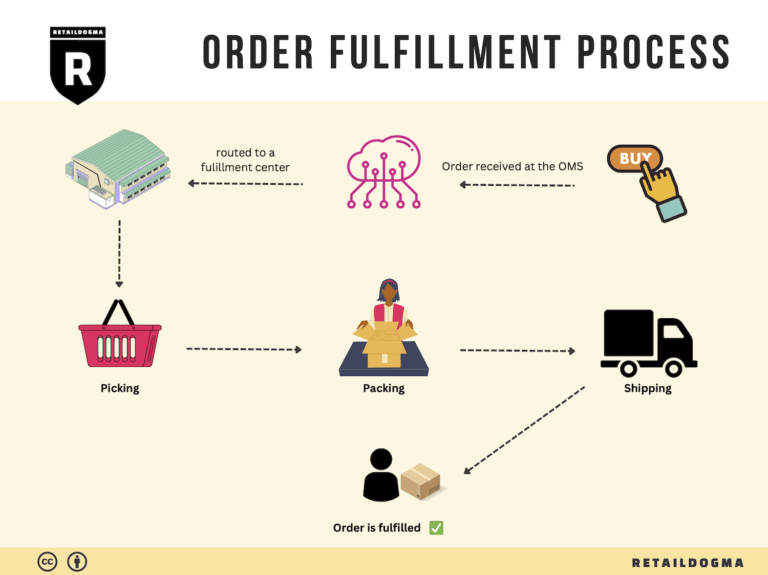How Order Fulfillment Works: A Step-by-Step Guide for Businesses
What is E-commerce Fulfillment? An Introduction for Growing Businesses
Understanding E-commerce Fulfillment
As your online business begins to thrive, the excitement of increased sales can quickly turn into stress as you grapple with the complexities of packing and shipping orders. Many growing e-commerce entrepreneurs find themselves overwhelmed by the logistical challenges that come with fulfilling customer orders. This is where e-commerce fulfillment plays a crucial role. Simply put, fulfillment is the process of getting a product from your inventory into the hands of your customer, encompassing everything from order processing and packing to shipping and delivery.
Navigating the world of e-commerce fulfillment can be daunting, especially with the various models available. In this guide, we will explore different fulfillment options, including third-party logistics (3PL) providers, Fulfillment by Amazon (FBA), and more. Each model offers unique advantages and potential drawbacks, making it essential to understand how they align with your business needs.
We will also delve into the core services that fulfillment partners typically offer. From inventory management and order processing to shipping and returns handling, knowing what to expect from a fulfillment partner can help you streamline your operations and enhance your customer experience.
Choosing the right fulfillment partner is a critical decision that can significantly impact your business’s efficiency and scalability. In this guide, we will outline key factors to consider when selecting a partner, such as their technology capabilities, shipping options, pricing structures, and customer service.
Speaking of pricing, understanding the cost implications of various fulfillment options is vital for maintaining healthy profit margins. We will break down the pricing models associated with different fulfillment strategies, helping you to make informed financial decisions as you scale your operations.
The ultimate goal of this guide is to empower you—business owners, operations managers, and entrepreneurs—to make smart logistics decisions that support your growth. By demystifying the fulfillment process and providing actionable insights, we aim to help you navigate this essential aspect of your e-commerce business with confidence and clarity.

What You’ll Learn In This Guide
- What is E-commerce Fulfillment? An Introduction for Growing Businesses
- The Order Fulfillment Process: From ‘Buy’ Button to Customer’s Door
- Comparing Fulfillment Models: In-House vs. 3PL vs. Dropshipping
- A Deep Dive into Amazon FBA: Pros, Cons, and Who It’s For
- Core Services Offered by Fulfillment Centers
- How to Choose a Fulfillment Partner: A 6-Point Checklist
- Understanding Fulfillment Pricing: A Breakdown of Common Fees
- Frequently Asked Questions (FAQs) about Fulfillment
- Conclusion: Is Outsourcing Fulfillment the Right Move for Your Business?
- Important Disclaimer
The Order Fulfillment Process: From ‘Buy’ Button to Customer’s Door
1. Receiving Inventory
The first step in the order fulfillment process is receiving inventory. This involves the acceptance of goods from suppliers into your warehouse or fulfillment center. Upon arrival, the inventory is checked against purchase orders to ensure that the correct quantities and items are received. Key terms associated with this stage include SKU (Stock Keeping Unit), which is used to track inventory items uniquely.
This step is critical for maintaining accurate inventory levels and ensuring that your fulfillment operations run smoothly. Any discrepancies in received goods can lead to stockouts or overstock situations, which can negatively impact customer satisfaction and cash flow. Therefore, establishing a systematic process for receiving inventory, including thorough inspections and proper documentation, is essential.
2. Warehouse Storage
Once the inventory is received and verified, it is stored in the warehouse. Efficient warehouse storage involves organizing products in a way that maximizes space and facilitates easy access. Key terminology relevant to this stage includes bin locations, which refer to specific storage areas assigned to particular products.
Proper warehouse storage is vital as it directly influences the speed and efficiency of order fulfillment. By utilizing strategies such as ABC analysis (categorizing inventory based on sales frequency) or implementing a just-in-time (JIT) inventory system, businesses can minimize storage costs and ensure that popular items are readily accessible. This organization not only improves operational efficiency but also reduces the likelihood of picking errors during order fulfillment.
3. Order Picking
The next step is order picking, where items are selected from the warehouse to fulfill customer orders. This process can be carried out using various methods such as single order picking, where one order is picked at a time, or batch picking, where multiple orders are picked simultaneously. A key term here is pick lists, which are documents that detail the items and quantities needed for each order.
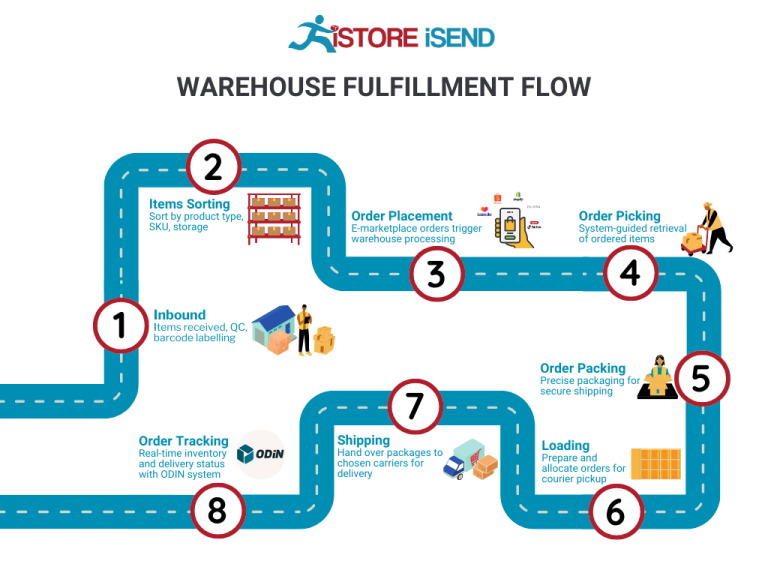
Order picking is crucial because it directly affects the speed and accuracy of order fulfillment. Efficient picking strategies can significantly reduce the time taken to process orders, leading to faster delivery times and improved customer satisfaction. Employing technologies such as barcode scanning or pick-to-light systems can enhance the picking process, minimize errors, and streamline workflows.
4. Order Packing
After picking, the next step is order packing. This involves preparing the picked items for shipment by placing them in appropriate packaging. Key considerations during this stage include selecting the right size and type of packaging, as well as including necessary documentation such as packing slips or invoices.
Packing is an essential part of the fulfillment process, as it ensures that products are protected during transit and that all items are accounted for. Proper packing techniques can also reduce shipping costs and improve the customer’s unboxing experience. Businesses should consider using void fill materials to prevent damage and ensure that products arrive in pristine condition. Additionally, effective packing can enhance brand perception and encourage repeat purchases from satisfied customers.
5. Shipping & Delivery
The final step in the order fulfillment process is shipping and delivery. Once the order is packed, it is labeled and dispatched to the chosen carrier for delivery to the customer. Key terms associated with this stage include shipping labels, which contain essential information such as the destination address and tracking number.
Shipping and delivery are critical for customer satisfaction, as they directly impact how quickly and reliably customers receive their orders. Businesses should aim to offer multiple shipping options, including expedited services, to meet varying customer needs. Additionally, providing tracking information empowers customers to monitor their orders, enhancing their overall experience. By choosing reliable shipping partners and optimizing shipping routes, businesses can reduce shipping times and costs, ultimately leading to happier customers and increased loyalty.
In conclusion, mastering each step of the order fulfillment process is essential for e-commerce businesses looking to scale their operations effectively. By ensuring accuracy and efficiency from receiving inventory to shipping and delivery, businesses can enhance customer satisfaction and drive growth.

Comparing Fulfillment Models: In-House vs. 3PL vs. Dropshipping
Comparing Fulfillment Models
When deciding on a fulfillment model for your e-commerce business, understanding the differences between In-House Fulfillment, Third-Party Logistics (3PL), and Dropshipping is crucial. Each model has its unique characteristics, benefits, and challenges, which can significantly impact your operations and growth potential. Below is a comparison table that highlights the key aspects of each model.
| Model | Who Handles Inventory | Best For (Business Stage) | Key Advantage | Key Disadvantage |
|---|---|---|---|---|
| In-House Fulfillment | Your business | Established businesses | Full control over inventory and operations | High overhead costs and complexity |
| Third-Party Logistics (3PL) | 3PL provider | Growing businesses | Scalability and expertise in logistics | Less control over inventory and fulfillment speed |
| Dropshipping | Supplier | Startups and small businesses | Low upfront investment and risk | Lower profit margins and potential quality control issues |
In-House Fulfillment
In-House Fulfillment involves managing your own warehousing and shipping operations. This model means that your business handles all aspects of inventory management, from storage to packing and shipping orders directly to customers. Typically, this approach suits established businesses that have the infrastructure and resources to manage logistics effectively.
Key Advantages: The primary advantage of In-House Fulfillment is the level of control it offers. Businesses can customize their packing processes, manage inventory levels precisely, and directly oversee the quality of the shipping experience. This can enhance customer satisfaction, as businesses can implement tailored shipping options and branding on packaging.
Key Disadvantages: However, the drawbacks include high overhead costs, such as warehouse rent, staffing, and technology investments. Additionally, businesses must invest time and resources into logistics management, which can detract from other critical areas like marketing or product development. As order volumes grow, scaling up operations can become complex and costly.
Third-Party Logistics (3PL)
Third-Party Logistics (3PL) involves outsourcing logistics to a specialized provider that manages warehousing, inventory management, and order fulfillment on behalf of your business. This model is particularly advantageous for growing businesses that need to scale quickly without the burden of managing logistics in-house.
Key Advantages: One of the most significant benefits of 3PL is scalability. As your business grows, a 3PL provider can easily adapt to increased order volumes and expanded product lines. Additionally, these providers often have advanced logistics technology and expertise, which can enhance efficiency and reduce shipping times. This allows businesses to focus on core competencies while leaving logistics to the experts.
Key Disadvantages: On the flip side, outsourcing fulfillment means relinquishing some control over inventory and order processing. Businesses may face challenges with communication and alignment on fulfillment expectations, which can lead to discrepancies in inventory levels or shipping times. Moreover, the costs associated with 3PL services can add up, especially during peak seasons or when additional services are required.
Dropshipping
Dropshipping is a fulfillment model where a business sells products without holding any inventory. Instead, when an order is placed, the business purchases the item from a third-party supplier who then ships it directly to the customer. This model is particularly appealing to startups and small businesses due to its low upfront investment.
Key Advantages: The most significant advantage of dropshipping is the minimal financial risk. Since businesses do not invest in inventory upfront, they can offer a wide range of products without the associated costs of storage and handling. This model allows for rapid market testing and product offerings, making it easier to pivot based on customer demand.
Key Disadvantages: However, dropshipping can also present challenges. Profit margins tend to be lower since suppliers set the prices. Additionally, businesses have limited control over product quality and shipping times, which can lead to customer dissatisfaction if suppliers fail to deliver as promised. This model also requires businesses to invest time in finding reliable suppliers and managing relationships, which can be a challenge in a competitive landscape.
Conclusion
Selecting the right fulfillment model is a critical decision for e-commerce businesses and can significantly influence operational efficiency and customer satisfaction. In-House Fulfillment offers control but at a high cost, 3PL provides scalability and expertise but less direct oversight, and Dropshipping minimizes risk but can lead to lower margins and quality issues. Entrepreneurs must assess their current business stage, resource availability, and long-term goals to choose the fulfillment strategy that aligns best with their operational needs and growth aspirations.
A Deep Dive into Amazon FBA: Pros, Cons, and Who It’s For
What is Fulfillment by Amazon (FBA)?
Fulfillment by Amazon (FBA) is a service provided by Amazon that allows sellers to store their products in Amazon’s fulfillment centers. Once products are stored, Amazon takes care of the entire fulfillment process, including picking, packing, shipping, and customer service. This service is particularly beneficial for e-commerce business owners looking to streamline their logistics and enhance their customer experience.
When a customer places an order for a product fulfilled by FBA, Amazon handles the entire transaction. This includes managing inventory, processing orders, and dealing with returns. Sellers benefit from Amazon’s extensive logistics network, which allows for quick shipping and reliable delivery options. Additionally, products fulfilled through FBA are eligible for Amazon Prime, which can significantly boost sales due to the appeal of fast, free shipping.
How FBA Works
-
Inventory Storage: Sellers send their products to Amazon’s fulfillment centers. Each product is labeled according to Amazon’s requirements, and sellers can track their inventory through the Amazon Seller Central dashboard.
-
Order Processing: When a customer orders a product, Amazon’s systems automatically recognize the order and initiate the fulfillment process. Amazon’s employees pick the item from the shelf, pack it, and ship it directly to the customer.
-
Shipping: FBA provides various shipping options, including next-day and two-day shipping for Prime members. This capability is a significant advantage, as many consumers expect fast delivery.
-
Customer Service: Amazon also manages customer inquiries and returns for FBA orders, allowing sellers to focus more on their core business activities rather than customer service.
Pros of Fulfillment by Amazon (FBA)
-
Prime Eligibility: One of the most significant advantages of FBA is that it makes products eligible for Amazon Prime. This can lead to increased sales, as Prime members often prefer products that offer fast, free shipping.
-
Customer Trust: Amazon is a trusted brand worldwide. By using FBA, sellers can leverage Amazon’s reputation, which can enhance customer trust and encourage purchases.
-
Multi-Channel Fulfillment: FBA supports multi-channel fulfillment, allowing sellers to fulfill orders from their own websites or other sales channels using Amazon’s logistics. This flexibility can simplify operations and reduce overhead costs.
-
Scalability: FBA allows businesses to scale quickly without the need for significant investments in warehouse space or logistics infrastructure. Sellers can focus on growing their business while Amazon manages fulfillment.
-
Automated Inventory Management: FBA provides tools for tracking inventory levels, sales trends, and performance metrics, making it easier for sellers to manage their inventory efficiently.
Cons of Fulfillment by Amazon (FBA)
-
High Fees: One of the most significant drawbacks of FBA is the cost. Amazon charges various fees, including storage fees, fulfillment fees, and additional charges during peak seasons. These fees can eat into profit margins, especially for low-cost items.
-
Strict Inventory Rules: Amazon has stringent policies regarding inventory management, including labeling requirements and storage limits. Non-compliance can lead to penalties or even account suspension.
-
Commingling Risks: When using FBA, sellers’ products may be stored alongside those of other sellers. This commingling can lead to issues with returns, as sellers may receive products that were not theirs. It can also complicate quality control.
-
Loss of Customer Data: FBA limits sellers’ access to customer data. While Amazon manages customer interactions, sellers cannot directly communicate with their customers or build a customer relationship, which can hinder long-term brand loyalty.
-
Inventory Management Challenges: Sellers must manage their inventory levels carefully to avoid long-term storage fees or running out of stock, both of which can impact sales negatively.
Who is FBA Best For?
Fulfillment by Amazon is ideal for a variety of sellers, particularly:
-
Small to Medium-Sized Businesses: Those looking to scale without investing heavily in logistics infrastructure can benefit from FBA’s extensive network and operational efficiencies.
-
Brands with High Sales Volume: Businesses that sell high volumes of products can leverage FBA’s capabilities to handle large order volumes effectively.
-
Sellers Reaching International Markets: Brands looking to expand their reach globally can take advantage of Amazon’s international shipping capabilities.
-
New Sellers on Amazon: New e-commerce entrepreneurs can use FBA to simplify their logistics and focus on marketing and sales without getting bogged down in fulfillment challenges.
In summary, FBA can be a powerful tool for e-commerce businesses, offering numerous advantages, especially in terms of customer trust and logistics efficiency. However, sellers should carefully consider the associated costs and operational complexities to determine if it aligns with their business model and growth strategy. By weighing the pros and cons, entrepreneurs can make informed decisions about integrating FBA into their multi-channel fulfillment strategy.
Core Services Offered by Fulfillment Centers
Inventory Management & Warehousing
Inventory management and warehousing are fundamental services provided by fulfillment centers that enable e-commerce businesses to maintain optimal stock levels while minimizing overhead costs. Fulfillment centers offer dedicated storage space, where businesses can store their products in a secure and organized environment.
The key benefit of effective inventory management is the ability to track stock levels in real-time, which helps prevent stockouts and overstock situations. By utilizing advanced inventory management systems, fulfillment centers can provide insights into inventory turnover rates, seasonal trends, and sales forecasts. This data allows e-commerce businesses to make informed decisions about purchasing and restocking, ultimately enhancing cash flow and reducing excess inventory costs.
Moreover, warehousing services often include climate control options for sensitive products, ensuring that items are stored under optimal conditions. This aspect is particularly crucial for businesses dealing in perishable goods or products that require specific environmental conditions. By outsourcing these logistical challenges to a fulfillment center, e-commerce businesses can focus on core activities such as marketing and customer engagement, while ensuring their products are well-managed and readily available for order fulfillment.
Pick and Pack Services
Pick and pack services are a critical component of fulfillment operations, involving the process of selecting items from inventory (picking) and preparing them for shipment (packing). Fulfillment centers employ efficient picking methods, such as batch picking and wave picking, to streamline the order fulfillment process.
The main advantage of pick and pack services is the speed and accuracy they bring to the order fulfillment workflow. By leveraging technology such as barcode scanners and automated picking systems, fulfillment centers can significantly reduce errors in order fulfillment, enhancing customer satisfaction. Fast and accurate order processing is vital in today’s e-commerce landscape, where consumers expect quick delivery times and precise order accuracy.
Additionally, fulfillment centers often provide customized packing options, allowing e-commerce businesses to present their products professionally. This can include branded packaging, gift wrapping, or the inclusion of promotional materials. Such customizations not only enhance the unboxing experience but also foster brand loyalty, encouraging repeat purchases.
Kitting and Assembly
Kitting and assembly services involve the combination of multiple products into a single package or kit, which can be particularly beneficial for businesses offering bundled products or promotional items. Fulfillment centers can handle the entire kitting process, from assembly to packaging, ensuring that products are prepped and ready for shipment.
The primary benefit of kitting and assembly services is the time and labor savings they provide. Instead of e-commerce businesses having to manage the labor-intensive process of assembling kits in-house, they can rely on fulfillment centers to handle this efficiently. This not only reduces operational overhead but also allows businesses to scale their offerings without the need for additional labor or workspace.
Furthermore, kitting can enhance the perceived value of products by creating unique bundles that appeal to consumers. For example, a skincare brand might offer a kit that includes a cleanser, moisturizer, and sunscreen at a discounted price. Such strategies can increase average order value and drive customer engagement, making kitting an essential service for e-commerce businesses looking to optimize their product offerings.
Returns Management (Reverse Logistics)
Returns management, or reverse logistics, is an often-overlooked but crucial service provided by fulfillment centers. This service encompasses the processes involved in handling returned products, from receiving and inspecting returns to restocking or disposing of items as necessary.
The benefits of effective returns management are twofold. First, it significantly enhances the customer experience. In an era where consumers prioritize hassle-free returns, e-commerce businesses that can offer a streamlined returns process are more likely to gain customer trust and loyalty. Fulfillment centers can provide clear return instructions, process returns quickly, and manage customer communications, ensuring that the experience is as smooth as possible for the buyer.
Second, efficient returns management can improve inventory accuracy and reduce losses. Fulfillment centers utilize technology to track returned items, ensuring that they are either restocked or appropriately dealt with in a timely manner. This not only minimizes the financial impact of returns but also helps maintain accurate inventory records, which is essential for future sales forecasting and inventory management.
In conclusion, fulfillment centers offer a suite of core services that are vital for e-commerce businesses aiming to scale operations effectively. From inventory management and pick and pack services to kitting and returns management, each service is designed to optimize logistics, enhance customer satisfaction, and ultimately drive sales growth. By leveraging these services, e-commerce businesses can focus on their strategic objectives while ensuring that their operational needs are met efficiently and effectively.
How to Choose a Fulfillment Partner: A 6-Point Checklist
Location & Warehouse Network
Importance:
The geographical location of your fulfillment partner’s warehouses can significantly impact shipping times and costs. A partner with strategically placed warehouses can reduce transit times to your customers, leading to better service levels and customer satisfaction.
Questions to Ask:
1. Where are your fulfillment centers located?
2. How do these locations align with my target customer base?
3. Do you have the capability to ship internationally, and if so, what are the associated costs?
4. How often do you evaluate and expand your warehouse network?
Technology & Integrations
Importance:
In today’s digital landscape, a fulfillment partner’s technological capabilities are critical for seamless operations. The ability to integrate with your e-commerce platforms, inventory management systems, and other tools ensures real-time visibility and efficiency in order processing.
Questions to Ask:
1. What technology platforms do you use for order management and fulfillment?
2. Are you compatible with major e-commerce platforms such as Shopify, WooCommerce, or Magento?
3. How do you handle inventory tracking, and is it accessible in real-time?
4. Can you provide API access for custom integrations, and what does that process entail?
Specializations (e.g., cold storage, oversized items)
Importance:
Different businesses have unique fulfillment needs based on the type of products they sell. If you deal with perishable goods, oversized items, or specialized products, it’s essential to partner with a fulfillment provider that has the necessary infrastructure and expertise.
Questions to Ask:
1. What types of products do you specialize in fulfilling?
2. Do you have specialized facilities (e.g., climate-controlled environments for food or pharmaceuticals)?
3. How do you handle fragile or oversized items during storage and shipping?
4. What safety and compliance measures do you have in place for specialized products?
Scalability & Capacity
Importance:
As your business grows, your fulfillment needs will likely change. A good fulfillment partner should be able to scale operations without compromising service quality. This includes having the capacity to handle peak seasons and sudden surges in demand.
Questions to Ask:
1. How do you manage fluctuations in order volume, especially during peak seasons?
2. What is your current capacity, and how quickly can you scale up if necessary?
3. Have you successfully managed scaling for other clients? Can you share examples?
4. What are your contingency plans in case of unexpected spikes in order volume?
Pricing and Contracts
Importance:
Understanding the pricing structure and contract terms is crucial for maintaining profitability. Transparency in pricing helps prevent unexpected costs that can erode your margins. Additionally, flexible contract terms can provide peace of mind as your business evolves.
Questions to Ask:
1. What is your pricing model (e.g., per order, per item, monthly fees)?
2. Are there any hidden fees (e.g., for storage, returns, peak seasons)?
3. What are the contract terms, and is there flexibility for adjustments as my business grows?
4. Can you provide a detailed breakdown of all costs associated with your services?
Customer Support & Reviews
Importance:
Reliable customer support is vital for addressing issues that may arise in the fulfillment process. Additionally, checking reviews and testimonials from other clients can provide insight into the partner’s reliability and service quality.
Questions to Ask:
1. What levels of customer support do you offer (e.g., dedicated account manager, 24/7 support)?
2. How quickly can I expect a response to inquiries or issues?
3. Can you provide references or case studies from similar businesses?
4. What is your process for handling fulfillment errors or customer complaints?
Conclusion
Choosing the right fulfillment partner is a critical decision for scaling your e-commerce business. By thoroughly evaluating potential partners against this checklist, you can ensure that you select a provider that aligns with your operational needs and growth ambitions. Prioritize the factors that matter most to your business, and don’t hesitate to ask for detailed information and clarifications to make an informed choice.
Understanding Fulfillment Pricing: A Breakdown of Common Fees
Initial Setup Fees
When engaging with a fulfillment service, the initial setup fees represent the costs associated with integrating your e-commerce platform with the fulfillment provider’s systems. This may include account setup, API integration, and software configuration. Depending on the provider, these fees can vary significantly, often ranging from $50 to several hundred dollars. Some providers may waive these fees to attract new clients, while others include them as part of a broader service package. It’s essential to understand what is included in these fees, as additional costs may arise later in the onboarding process, such as training for your team or adjustments in system configurations.
Receiving Fees
Receiving fees are charged when inventory is delivered to the fulfillment center. These fees cover the costs of unloading, inspecting, and storing the products upon arrival. The calculation typically depends on the volume of inventory being received and the complexity of the process. For instance, a fulfillment center might charge a flat fee per pallet or per carton. Some providers also implement tiered pricing, which means the more items you send, the lower the per-item cost may be. This fee can range from a few dollars to upwards of $50 per pallet, depending on the provider’s policies and the nature of the goods being received.
Storage Fees (per pallet/bin)
Storage fees are incurred for the space your inventory occupies within the fulfillment center. This fee is usually calculated on a monthly basis and can be structured in several ways—commonly as a per-pallet or per-bin rate. For example, a typical storage fee might be around $10 to $30 per pallet per month, with variations based on the time of year. Many fulfillment centers charge higher fees during peak seasons, such as the holidays, reflecting increased demand for storage space. Additionally, some providers may impose long-term storage fees if inventory remains unsold for an extended period, incentivizing sellers to manage their stock levels effectively.
Pick & Pack Fees (per item/order)
Pick and pack fees are the costs associated with selecting items from inventory and packaging them for shipment. These fees can vary based on the complexity of the order, the number of items included, and the specific packing requirements. For example, a fulfillment center may charge a base fee of $1 to $3 per order, plus an additional fee per item picked, which could be around $0.20 to $1.00. Discounts may be offered for larger orders or bulk shipments. Understanding this pricing model is crucial, as high pick and pack costs can significantly affect your overall fulfillment expenses, especially if you have a diverse product range with many SKUs.
Shipping Fees
Shipping fees are one of the most significant costs in the fulfillment process and are calculated based on several factors, including the weight and dimensions of the package, the shipping destination, and the desired delivery speed. Most fulfillment providers offer tiered shipping rates that decrease with larger volumes or through negotiated shipping contracts. It’s important to note that shipping fees can also vary significantly during peak seasons, with many providers implementing surcharges during high-demand periods. For e-commerce businesses, accurately estimating these costs is vital for pricing strategies and maintaining profit margins.
Tips for Getting an Accurate Quote
-
Provide Detailed Information: When seeking quotes from fulfillment providers, be as specific as possible about your inventory, order volume, and shipping requirements. This includes details about product dimensions, weight, and packaging needs.
-
Ask About All Fees: Ensure you inquire about every potential fee, including those that may not be immediately obvious, such as long-term storage fees or peak season surcharges.
-
Compare Multiple Providers: Don’t settle for the first quote you receive. Comparing offers from different providers allows you to identify the best pricing structure and services that suit your business needs.
-
Negotiate Terms: Many fulfillment providers are open to negotiation, especially if you can commit to a long-term partnership or demonstrate potential for high order volumes.
-
Review Contract Terms: Before finalizing any agreements, thoroughly review the contract to understand the terms of service, payment schedules, and any additional costs that may arise during the partnership.
By understanding these common fulfillment pricing models and following these tips, e-commerce businesses can better manage their logistics costs, ensuring a more efficient and profitable operation.
Frequently Asked Questions (FAQs) about Fulfillment
1. What is multi-channel fulfillment?
Multi-channel fulfillment refers to the process of managing inventory and shipping orders across multiple sales platforms, including your own e-commerce website, marketplaces like Amazon or eBay, and social media channels. It allows businesses to streamline their logistics operations by using a centralized fulfillment strategy, often through third-party logistics (3PL) providers or fulfillment centers.
2. How does multi-channel fulfillment work?
In multi-channel fulfillment, businesses store their inventory at a fulfillment center or 3PL provider, which handles order processing, picking, packing, and shipping for all sales channels. When an order is placed on any of the connected platforms, it is automatically routed to the fulfillment center, where the items are prepared and shipped directly to the customer.
3. What is the difference between a warehouse and a fulfillment center?
A warehouse is primarily a storage space for goods, focusing on inventory management and long-term storage. In contrast, a fulfillment center is designed for order processing and shipping, equipped with systems to quickly pick, pack, and dispatch products. Fulfillment centers often provide additional services like returns processing and inventory management, making them essential for e-commerce operations.
4. What is a 3PL?
A third-party logistics (3PL) provider is a company that offers outsourced logistics services, including warehousing, fulfillment, and transportation. Businesses partner with 3PLs to leverage their expertise and infrastructure, enabling them to focus on core business activities while ensuring efficient order fulfillment and delivery.
5. How much do fulfillment services cost?
Fulfillment service costs vary based on several factors, including the provider, the volume of orders, the size and weight of products, and the specific services required. Typical charges include storage fees (based on space occupied), fulfillment fees (per order processed), and additional fees for services such as returns or special packaging. It’s essential to request detailed pricing from potential providers to understand the total cost structure.
6. What are the benefits of using multi-channel fulfillment?
Using multi-channel fulfillment can enhance customer satisfaction through faster shipping, reduce operational complexity by centralizing logistics, and improve inventory management across platforms. It also enables businesses to reach a broader audience by selling on various channels while maintaining consistent service levels.
7. What challenges might I face with multi-channel fulfillment?
Challenges include managing inventory levels across multiple channels, ensuring seamless integration between sales platforms and fulfillment systems, and dealing with varying shipping costs and times. Additionally, businesses may face complexities in customer service and returns management when operating across different marketplaces.
8. How can I choose the right fulfillment partner?
To choose the right fulfillment partner, assess their capabilities, such as technology integration, shipping options, scalability, and customer service. Look for reviews and case studies from similar businesses, request quotes, and compare pricing structures. It’s crucial to ensure that the partner can meet your specific needs and scale with your growth.
9. How do I integrate my sales channels with a fulfillment center?
Integration typically involves using software or APIs that connect your sales platforms (like Shopify, Amazon, or eBay) with your fulfillment provider’s system. Many fulfillment centers offer ready-to-use integrations or plugins to facilitate this process. Ensure that the integration allows for real-time inventory updates and order tracking to maintain transparency across channels.
10. Can I use multi-channel fulfillment for international orders?
Yes, many fulfillment centers and 3PL providers offer international shipping options. However, it’s essential to confirm that your chosen provider can handle the complexities of international logistics, including customs clearance, duties, and taxes. Additionally, consider the shipping costs and delivery times for international orders, as these can vary significantly compared to domestic shipping.
Conclusion: Is Outsourcing Fulfillment the Right Move for Your Business?
Evaluating the Benefits of Outsourcing Fulfillment
Outsourcing fulfillment can be a transformative decision for e-commerce businesses aiming to scale operations efficiently. By leveraging a fulfillment service, businesses can save substantial time and resources that would otherwise be spent on inventory management, order processing, and shipping logistics. This allows you to redirect focus toward core business strategies, such as marketing and product development.
Scalability is another significant advantage. As your sales channels expand and order volumes increase, a fulfillment partner can easily adapt to your growing needs without the burden of additional infrastructure or personnel. This flexibility ensures that you can meet customer demand without compromising service quality. Moreover, established fulfillment partners bring valuable expertise to the table, optimizing supply chain processes and implementing best practices that can enhance overall efficiency and customer satisfaction.
However, the success of outsourcing fulfillment hinges on selecting the right partner. It’s crucial to align with a fulfillment provider that understands your business model and can accommodate your specific needs, whether that involves multi-channel integration, speed of delivery, or cost management. Conducting thorough due diligence—assessing capabilities, customer service, technology, and pricing structures—will be essential for long-term success.
Next Steps for Your Business
To determine if outsourcing fulfillment is the right move for your business, conduct an audit of your current shipping processes. Identify bottlenecks, costs, and inefficiencies that could be alleviated through a fulfillment partnership. Consider your growth trajectory and whether your current setup can support your ambitions. Taking this strategic step can clarify whether partnering with a fulfillment service is the next logical move in your journey toward scalable growth.
Important Disclaimer
⚠️ Important Disclaimer
The information in this guide is for educational purposes. Fulfillment services, pricing, and platform features change frequently. Always conduct your own due diligence and consult with providers directly before making business decisions.


